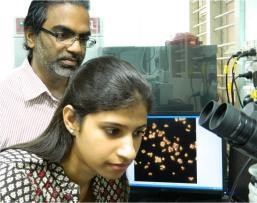Scientists at the Indian Institute of Technology, Madras (IIT-M) have developed an ingenious method to visually detect even a single molecule of the explosive TNT1 .
Researchers Ammu Mathew (front) and T. Pradeep. 
The IIT chemists used a combination of micro- and nanostructures called 'gold mesoflowers' as sensors. These are flower-shaped gold particles about 4 µm (millionths of a meter) in size. These gold flowers act as 'supports' for silver clusters which are tiny clumps of exactly 15 silver atoms embedded in protein bovine serum albumin.
This unique detector system works as follows: when irradiated with light of right wavelength (490 nm), the silver clusters luminesce, giving off red light. The nanostructures in the gold mesoflower intensifies the fluorescence. The distinct star shape of the mesoflower is of particular advantage because it is easy to unambiguously identify it under an optical microscope, says Pradeep.
If a drop of test solution containing TNT is applied, it reacts with the free amino groups of the bovine serum albumin to make a 'Meisenheimer complex' — a reaction specific to TNT. This reaction extinguishes the red glow of the silver clusters within one minute. The disappearance of the red glow can be seen visually under a microscope and is a clear indication of the presence of TNT.
In order to make this reaction even more distinct, the researchers also embedded a green fluorescing dye called 'fluorescein isothiocyanate (FITC)', on to a silicon dioxide layer grown on the gold flowers. As long as the silver clusters glow red, the green fluorescence is suppressed. When TNT molecules switch off the red light, the green dye begins to glow. The change of colour from red to green can be observed with a fluorescence microscope.
"A TNT concentration of one ppb (parts per billion) extinguishes the fluorescence whereas one ppt (part per trillion) reduces it markedly." According to Pradeep, just one 'flower' is enough to operate as a sensor. A device based on this principle is under development at the IIT-M, he told Nature India . The amount of gold required to make one mesoflower with a 4 mm edge length is about 0.288 nanogram and it can be recovered and reused.
The IIT-M scientists supplemented their luminescence technique with a second analytical method called surface-enhanced Raman scattering or SERS which also functions extremely well with a version of the flower-shaped sensors. "By combining the high sensitivity and selectivity offered by SERS with our sensing method, we enhance the accuracy and reliability of the detection technique," the researchers said.
The researchers were also able to detect mercury with this method. Pradeep says the concept could also be used for the ultra-trace analysis of other substances through the incorporation of specific ligands (or molecules) on the sensors. This, he says, will open up applications in catalysis, bio-imaging and other areas. "This approach can be considered a single-particle, single-molecule detection technique which is, probably, the ultimate in ultra-trace sensitivity."
